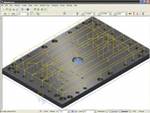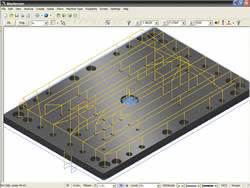No-cost CAM Upgrade Gives Moldmaker Major Productivity Boosts
The latest version of Mastercam CAM software from CNC Software, Inc. contains several new features that will greatly improve productivity, especially roughing and fine finishing.
Two of the most labor-intensive and costly operations in a mold shop are roughing and fine finishing. The first of these involves hogging out large amounts of material to manufacture mold plates as well as getting EDM electrodes and machined mold components to near net shape for finish machining. Roughing costs are two-fold—the long amounts of time it generally takes to remove the material and the costs associated with replacing worn tooling.
Finishing costs include the time it takes to write complex CAM programs with the minute stepovers that the moldmaker hopes will result in mirror finishes, along with the numerous hours it takes to hand polish areas that come off the machine without complying to the user’s surface finish specifications. These hours are not only expensive, but also tend to be anxiety-ridden because there is a customer somewhere waiting for the delivery of his mold and he will only be getting it after hours of tedious manual polishing has been completed.
So, it is no surprise that Dave King, owner of Choice Tool (Minneapolis, MN), was all ears when Brian Pascoe from Prototek Engineering (his local CAM reseller) called to inform him that these cost factors were about to change dramatically. Pascoe told King that the latest version of his CAM software, Mastercam from CNC Software, Inc. (Tolland, CT) contained several new features that would greatly improve his productivity, especially roughing and fine finishing.
Pascoe invited King to attend a free seminar that would be open to several Prototek customers. Instead, King negotiated with Pascoe to obtain a day of hands-on training for himself and another Mastercam user in his shop. King estimates that the day of personalized training paid for itself many times over the first time he used the new features he learned about during his training session.
Fortunate Downsizing
Dave King started his business in 1992 after the company he worked for, IBM, decided to downsize its tool and die manufacturing operations. Even though he was still in his twenties, he had 10 years of tool & die experience starting with IBM’s apprenticeship program. King knew how to operate CNC equipment, he had high-end CAM programming experience with CATIA, and the buyout he was about to receive would provide him with enough capital to finance a Fadal CNC machining center and a seat of Mastercam that he purchased from Prototek after an extensive review of all the software packages available at the time.
Today, Choice Tool is a diversified small company building injection molds, vacuum form and die cast tooling for customers primarily in the consumer products, recreational vehicle and medical device manufacturing industries. Over the years, King has kept his business small and lean, and the business has continued to grow by word of mouth, even through difficult times.
He outsources all of his design work to a trusted engineering partner who provides him with SolidWorks files that can be opened natively in Mastercam. This has allowed him and his staff of four qualified toolmakers (including himself) to focus 100 percent of their time and energy on manufacturing. To keep everything simple, straightforward and interchangeable, Choice Tool has standardized on Fadal machining centers. “Now, when I train someone, I don't have to train them on two different controllers or multiple pieces of equipment or software. This also gives me the flexibility to run a job on any of several pieces of equipment to keep projects moving,” says King.
The company now has three Fadal machining centers along with two die sinker EDMs and a CNC lathe, which are all programmed with Mastercam. King is the primary programmer, but all of the staff can use Mastercam, and they are encouraged to keep improving their skills with it.
Productivity Jumps
King notes, “It has been amazing to watch the jumps in productivity improvements that occur from time to time with the Mastercam software. The new roughing and finishing technology is just one of several of these jumps that have come along over the years to help me stay competitive with overseas tool builders who are always in the background. Typically, I get the job when my customer is on a very short deadline and needs the tooling in a matter of weeks. Advancements in manufacturing technology and especially the software have allowed me to answer this need. These days I can't wait to see what Mastercam will come out with next because it's always a money-saving deal.”
The specific CAM technology improvements that Choice Tool received training in were OptiRough (a 3-D full flute roughing toolpath based on Mastercam’s Dynamic Milling technology) and the unique advanced Toolpath Refinement algorithm used for making granular changes to finishing toolpaths in order to achieve exceptionally high surface finishes.
Instead of using just the tip of the tool with high engagement and low speeds, the OptiRough approach turns conventional wisdom on its head, always using as much flute length as possible at high speeds with minimal engagement. OptiRough constantly monitors tool engagement and adjusts the toolpath to maintain a consistent load on the workpiece and the tool.
After the training, Choice Tool began using OptiRough extensively. King estimates that roughing time on his Fadals has been reduced between 50 and 75 percent, while tooling costs have been lowered by about 25 percent. Those are very big savings at the front end of his CNC manufacturing processes.
For the back end of his manufacturing process, the training experience provided at least an equal payoff. For intricate finishing operations, he was showed how to employ Mastercam’s Toolpath Refinement algorithm that makes it possible to achieve exceptionally high finishes that in the past were only possible after hour upon hour of manual polishing with a stone.
If the CAM system’s standard toolpaths cannot provide the desired finish, Toolpath Refinement can be used to analyze the density of G-code points, remove them where they are excessive, and insert them where they are sparse. Toolpath refinement provides the CNC machine’s controller with an ideal point set for the optimal management of acceleration and deceleration in confined areas of the part to produce a more uniform and finer finish that was before impossible to obtain without hand polishing.
Soon, Choice Tool was shaving hours of manual polishing time from high surface finish jobs by using toolpath refinement and operating equipment on a lights out basis to do all the extra fine finishing. “I would much rather be home watching Monday night football, instead of me or someone else spending all that extra time polishing molds,” King says.
Wildest Part
Toolpath refinement was put to the ultimate test in the spring when a customer that manufactures arcade games came to Choice Tool with a challenging assignment. The customer needed a mold for a machine gun used in an ultra-realistic video war game. The customer was very enthusiastic about the design and absolutely had to have the product for a trade show that was less than two months away. The molds had to be delivered in just four weeks.
The two mold halves are 32 inches long and very intricate with all sorts of cavities inside to house numerous electro-mechanical components including a vibrator that makes the product feel like a real machine gun when it was being fired. On the outside, a high surface finish was required so that the product has the look of polished metal.
Because of the tight spaces involved, this would have normally been a job that would have taken about two weeks just to polish. The customer was not allowing Choice Tool that amount of time. When it came to creating the program for manufacturing the mold halves, King said it took about two hours to create the programs for making the long electrodes that would be used to EDM the two mold halves. Then Choice Tool set up the workpieces on identical Fadal CNCs, which completed the parts after 48 consecutive hours of lights-out machining. The majority of this machining time was tight space finishing with toolpath refinements.
As predicted, the fine finish on the electrodes eliminated weeks worth of manual labor to finish the molds. “The customer got to make his new products in time to go to his trade show. Now he has been selling thousands of them,” notes King. “And I got to go on a fishing trip to Alaska.”
Back from the Wilds and Wondering
In late September, King and Pascoe returned from a fishing trip in Alaska with hundreds of pounds of fresh frozen halibut to show for their efforts. The trip was a prize for winning Mastercam’s Wildest Part Competition. Pascoe was so impressed by the electrode that Choice Tool had made that he entered it in the international contest. It was judged to be one of the finalists and, ultimately, the grand prize winner.
King said he was a little uneasy spending so much of his time away from the shop on something as frivolous as a fishing trip. But he had spent years carefully selecting his equipment, standardizing his procedures and making sure his toolmakers were also qualified CAM operators. As he was walking in the door on his first morning back, he was wondering what problems would be waiting for him. There weren’t any.
Related Content
How to Select a Mold Temperature Controller
White paper shares how cooling channel analysis, which collects maximum pressure drop, total flow rate and heat dissipation, eases the performance evaluation of mold temperature controllers.
Read MoreHow to Analyze and Optimize Cutting Conditions to Reduce Cycle Time
Plastic injection mold design and manufacturing company puts NC program optimization software module to the test. The results were surprising.
Read MoreMold Design Review: The Complete Checklist
Gerardo (Jerry) Miranda III, former global tooling manager for Oakley sunglasses, reshares his complete mold design checklist, an essential part of the product time and cost-to-market process.
Read MoreHow a Small Programming Change Cuts Cycle Time in Half
Overriding the CAM system when milling a series of lifter pockets helps to improve metal removal rate and increase feed rates.
Read MoreRead Next
The Many Dimensions of Feature-Based Machining
Simple does not mean minimal. FBM is a powerful tool that can save many different types of users’ time and money. Here’s why.
Read MoreHow to Use Strategic Planning Tools, Data to Manage the Human Side of Business
Q&A with Marion Wells, MMT EAB member and founder of Human Asset Management.
Read MoreReasons to Use Fiber Lasers for Mold Cleaning
Fiber lasers offer a simplicity, speed, control and portability, minimizing mold cleaning risks.
Read More





















